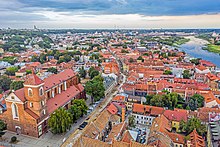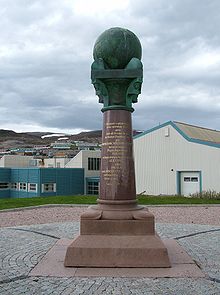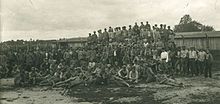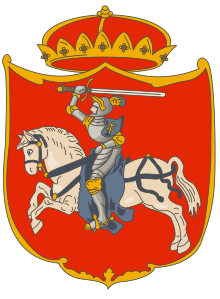Template:Transclude list item excerpts as random slideshow/testcases/Portal:Lithuania
| This is the template test cases page for the sandbox of Template:Transclude list item excerpts as random slideshow/testcases. Purge this page to update the examples. If there are many examples of a complicated template, later ones may break due to limits in MediaWiki; see the HTML comment "NewPP limit report" in the rendered page. You can also use Special:ExpandTemplates to examine the results of template uses. You can test how this page looks in the different skins and parsers with these links: |
Portal maintenance status: (June 2018)
|
Introduction



Lithuania, officially the Republic of Lithuania, is a country in the Baltic region of Europe. It is one of three Baltic states and lies on the eastern shore of the Baltic Sea, bordered by Latvia to the north, Belarus to the east and south, Poland to the south, and the Russian semi-exclave of Kaliningrad Oblast to the southwest, with a maritime border with Sweden to the west. Lithuania covers an area of 65,300 km2 (25,200 sq mi), with a population of 2.89 million. Its capital and largest city is Vilnius; other major cities include Kaunas, Klaipėda, Šiauliai and Panevėžys. Lithuanians belong to the linguistic group of the Balts and speak Lithuanian.
For millennia, the southeastern shores of the Baltic Sea were inhabited by various Baltic tribes. In the 1230s, Lithuanian lands were united for the first time by Mindaugas, who formed the Kingdom of Lithuania on 6 July 1253. Subsequent expansion and consolidation resulted in the Grand Duchy of Lithuania, which by the 14th century was the largest country in Europe. In 1386, the Grand Duchy entered into a de facto personal union with the Crown of the Kingdom of Poland. The two realms were united into the bi-confederal Polish-Lithuanian Commonwealth in 1569, forming one of the largest and most prosperous states in Europe. The Commonwealth lasted more than two centuries, until neighbouring countries gradually dismantled it between 1772 and 1795, with the Russian Empire annexing most of Lithuania's territory.
Towards the end of World War I, Lithuania declared Independence in 1918, founding the modern Republic of Lithuania. In World War II, Lithuania was occupied by the Soviet Union, then by Nazi Germany, before being reoccupied by the Soviets in 1944. Lithuanian armed resistance to the Soviet occupation lasted until the early 1950s. On 11 March 1990, a year before the formal dissolution of the Soviet Union, Lithuania became the first Soviet republic to break away when it proclaimed the restoration of its independence. (Full article...)
Selected pictures
-
Image 4Statutes of Lithuania were the central piece of Lithuanian law in 1529–1795. (from Lithuania)
-
Image 6The Great Courtyard of Vilnius University and the Church of St. Johns (from Culture of Lithuania)
-
Image 9Lithuania's GDP per capita compared to rest of the world (2022) (from Lithuania)
-
Image 11The white stork is the national bird of Lithuania, which has the highest-density stork population in Europe. (from Lithuania)
-
Image 13The earliest known Lithuanian glosses (between 1520 and 1530) written in the margins of Johann Herolt book Liber Discipuli de eruditione Christifidelium. Words: teprÿdav[ſ]ʒÿ (let it strike), vbagÿſte (indigence). (from Lithuania)
-
Image 15Members of the Council of Lithuania after signing the Act of Independence of Lithuania in 1918 (from Lithuania)
-
Image 17Real GDP per capita development of Estonia, Latvia and Lithuania (from Lithuania)
-
Image 19The first Lithuanian printed book, Catechism of Martynas Mažvydas (1547, Königsberg) (from Lithuania)
-
Image 20Vilnius University, one of the oldest universities in the region. It was established by Stephen Báthory, King of Poland and Grand Duke of Lithuania, in 1579. (from Lithuania)
-
Image 22Le Château — Conte de fées (Lithuanian: Pilis — Pasaka) by Mikalojus Konstantinas Čiurlionis (1909) (from Culture of Lithuania)
-
Image 26Lithuania's name in writing (Litua, on line 7), 1009 (from Lithuania)
-
Image 27Changes in the territory of Lithuania from the 13th to 15th century. At its peak, Lithuania was the largest state in Europe. (from Lithuania)
-
Image 32A ceremony of Lithuanian modern pagans. (from Culture of Lithuania)
-
Image 36Guests of the 2023 Vilnius (NATO) summit in the Courtyard of the Presidential Palace in Vilnius (from Lithuania)
-
Image 37Traditional Lithuanian house from late 19th century (from Culture of Lithuania)
-
Image 40Chapel of Saint Casimir, the patron saint of Lithuania and Lithuanian youth, with his sarcophagus in the centre (from Lithuania)
-
Image 42Panorama of Vilnius in 1600 (from Lithuania)
-
Image 48Major highways in Lithuania (from Lithuania)
-
Image 49Cepelinai, a potato-based dumpling dish characteristic of Lithuanian cuisine with meat, curd or mushrooms (from Lithuania)
-
Image 54Stamp dedicated to Lithuania's presidency of the European Union. Post of Lithuania, 2013. (from Lithuania)
-
Image 56Simple Words of Catechism by Martynas Mažvydas was the first Lithuanian book and was published in 1547. (from Culture of Lithuania)
-
Image 58Cepelinai served with sour cream (from Culture of Lithuania)
-
Image 64The title page of Radivilias (1592, Vilnius). The poem celebrating commander Mikalojus Radvila Rudasis (1512–1584) and recounts the famous victory of Lithuanian Armed Forces over Moscow troops (1564). (from Lithuania)
-
Image 65Commemoration of the Act of the Re-Establishment of the State of Lithuania in the historical Seimas hall where it was originally signed in 1990. The ceremony is attended by the Lithuanian President, Prime Minister, Chairman of the Seimas and other high-ranking officials. (from Lithuania)
-
Image 66Lithuanian artist Jonas Mekas, regarded as godfather of American avant-garde cinema (from Culture of Lithuania)
-
Image 67Lithuanian basketball clubs Žalgiris and Šiauliai playing a match (from Culture of Lithuania)
-
Image 68Rock band Antis, which under firm censorship actively mocked the Soviet Union regime by using metaphors in their lyrics, during an anti-Sovietism, anti-communism concert in 1987 (from Lithuania)
-
Image 71Population density in Lithuania by elderships (from Lithuania)
-
Image 74Trakai Island Castle, the former residence of the Grand Dukes. Trakai was the capital of the medieval state. (from Lithuania)
-
Image 75Lithuanian Army soldiers marching with their dress uniforms in Vilnius. An officer stands out with a sword. (from Lithuania)
-
Image 77Baltic amber was a valuable trade item, transported from the region of modern-day Lithuania to the Roman Empire through the Amber Road. (from Lithuania)
-
Image 79Lithuanian cemetery at All Souls night (from Culture of Lithuania)
-
Image 81Lithuania was a member of the United Nations Security Council. Its representatives are on the right side. (from Lithuania)
-
Image 82Physical map and geomorphological subdivision of Lithuania (from Lithuania)
-
Image 83Emilia Plater leading peasant scythemen during the 1831 Uprising against Russian Empire; often nicknamed as a Lithuanian Joan of Arc (from Lithuania)
-
Image 84Gryčia (traditional dwelling house, built in the 19th century) (from Lithuania)
-
Image 86Lithuanian counties by GDP per capita, 2022 (from Lithuania)
-
Image 87Lithuania men's national basketball team is ranked eighth worldwide in FIBA Rankings. (from Lithuania)
Selected county
-
Image 1
Kaunas County (Lithuanian: Kauno apskritis) is one of ten counties of Lithuania. It is in the centre of the country, and its capital is Kaunas. On 1 July 2010, the county administration was abolished. (Full article...) -
Image 2
Utena County (Lithuanian: Utenos Apskritis) is one of ten counties in Lithuania. It is the country's most sparsely populated county. The capital and the largest city in the county is Utena, which is 95 km (59 mi) from Vilnius, the capital of Lithuania. On 1 July 2010, the county administration was abolished. Since that date, Utena County remains as the territorial and statistical unit. It borders Latvia. (Full article...) -
Image 3
Telšiai County (Lithuanian: Telšių apskritis) is one of ten counties in Lithuania. It is in the west of the country, and its capital is Telšiai. There are Lithuanians (98.7%), Latvians (0.1%), Russians (0.9%), and others (0.3%). On 1 July 2010, the county administration was abolished, and since that date, Telšiai County remains as the territorial and statistical unit. It borders Latvia. (Full article...) -
Image 4
Marijampolė County (Lithuanian: Marijampolės apskritis) is one of the ten counties in Lithuania. It is in the southwest of the country and roughly corresponds to the historical region of Sudovia. Its capital and the largest town is Marijampolė. On 1 July 2010, the county administration was abolished, and since that date, Marijampolė County remains as the territorial and statistical unit.
It borders the Tauragė County in the north, Kaunas County and Alytus County in the east, Podlaskie Voivodeship of Poland in the south and Kaliningrad Oblast of Russia in the west. (Full article...) -
Image 5

Klaipėda County (Lithuanian: Klaipėdos apskritis) is one of ten counties in Lithuania, bordering Tauragė County to the southeast, Telšiai County to the northeast, Kurzeme in Latvia to the north, and Kaliningrad Oblast in Russia to the south. To the west is the Baltic Sea. It lies in the west of the country and is the only county to have a coastline and not be landlocked. Its capital is Klaipėda. On 1 July 2010, the county administration was abolished, and since that date, Klaipėda County remains as the territorial and statistical unit. (Full article...) -
Image 6
Alytus County (Lithuanian: Alytaus apskritis) is one of ten counties in Lithuania. It is the southernmost county, and its capital is the city of Alytus. Its territory lies within the ethnographic region of Dzūkija. On 1 July 2010, the county administration was abolished, and since that date, Alytus County remains as the territorial and statistical unit.
It borders the Vilnius County in the east, Marijampolė County and Kaunas County in the north, Podlaskie Voivodeship of Poland in the west, and Grodno Region of Belarus in the south. (Full article...) -
Image 7
Vilnius County (Lithuanian: Vilniaus apskritis) is the largest of the 10 counties of Lithuania, located in the east of the country around the city Vilnius and is also known as Capital Region or Sostinės regionas by the Lithuanian statistics department and Eurostat. On 1 July 2010, the county administration was abolished, and since that date, Vilnius County remains as the territorial and statistical unit. (Full article...) -
Image 8
Šiauliai County (Lithuanian: Šiaulių apskritis) is one of ten counties in Lithuania. It is in the north of the country, and its capital is Šiauliai. On 1 July 2010, the county administration was abolished, and since that date, Šiauliai County remains as the territorial and statistical unit. It borders Latvia. (Full article...) -
Image 9
Panevėžys County (Lithuanian: Panevėžio apskritis) is one of ten counties in Lithuania. It is in the north-east of the country, and its capital is Panevėžys. On 1 July 2010, the county administration was abolished, and since that date, Panevėžys County remains as the territorial and statistical unit. (Full article...) -
Image 10
Tauragė County (Lithuanian: Tauragės apskritis) is one of ten counties in Lithuania. It is in the west of the country, and its capital is Tauragė. On 1 July 2010, the county administration was abolished, and since that date, Tauragė County remains as the territorial and statistical unit.
Famous landmarks include Tauragė Castle and Panemunė Castle. (Full article...)
Selected municipality
-
Image 1Landscape near Rūdaičiai
Kretinga District Municipality is one of 60 municipalities in Lithuania. (Full article...) -
Image 2
Šiauliai (/ʃaʊˈleɪ/ show-LAY; Lithuanian: [ɕɛʊ̯ˈlʲɛɪ̯ˑ] ⓘ) is a city in northern Lithuania, the country's fourth largest city and the sixth largest city in the Baltic States, with a population of 112 581 in 2024. From 1994 to 2010 it was the capital of Šiauliai County. (Full article...) -
Image 3

Zarasai District Municipality is one of 60 municipalities in Lithuania. It borders with Latvia and Belarus.
It has significant Russian minority population in Lithuania, with sixth of the population claiming Russian ethnicity. (Full article...) -
Image 4
Biržai District Municipality is a Lithuanian municipality, located in northern Lithuania, Aukštaitija ethnographic region, Panevėžys County.
The towns of Biržai and Vabalninkas lie within the district. About 64% of its land is agricultural, including a number of organic farms. Portions are protected in Biržai Regional Park and as botanical and geological reserves. (Full article...) -
Image 5
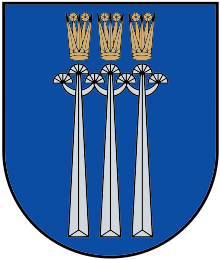
Druskininkai Municipality (Lithuanian: Druskininkų savivaldybė) is a municipality in Alytus County, Lithuania. (Full article...) -
Image 6Migoniai mound
Pasvalys District Municipality is one of 60 municipalities in Lithuania. (Full article...) -
Image 7
Tauragė District Municipality (Lithuanian: Tauragės rajono savivaldybė) is a municipality in Tauragė County, Lithuania
Famous landmarks include Tauragė Castle and Panemunė Castle. (Full article...) -
Image 8

Jurbarkas District Municipality (Lithuanian: Jurbarko rajono savivaldybė) is a municipality in Tauragė County, Lithuania (Full article...) -
Image 9
-
Image 10
Kaunas (/ˈkaʊnəs/; Lithuanian: [ˈkɐʊ̯ˑnˠɐs] ⓘ; previously known in English as Kovno /ˈkɒvnoʊ/) is the second-largest city in Lithuania after Vilnius, the fourth largest city in the Baltic States and an important centre of Lithuanian economic, academic, and cultural life. Kaunas was the largest city and the centre of a county [pl] in the Duchy of Trakai of the Grand Duchy of Lithuania and Trakai Palatinate since 1413. In the Russian Empire, it was the capital of the Kaunas Governorate from 1843 to 1915.
During the interwar period, it served as the temporary capital of Lithuania, when Vilnius was seized and controlled by Poland between 1920 and 1939. During that period Kaunas was celebrated for its rich cultural and academic life, fashion, construction of countless Art Deco and Lithuanian National Revival architectural-style buildings as well as popular furniture, interior design of the time, and a widespread café culture. The city interwar architecture is regarded as among the finest examples of European Art Deco and has received the European Heritage Label. It contributed to Kaunas being designated as the first city in Central and Eastern Europe as a UNESCO City of Design, and also to becoming a World Heritage Site in 2023 as the only European city representing large scale urbanization during the interwar period and versatile modernism architecture. (Full article...) -
Image 11

Vilnius District Municipality (Lithuanian: Vilniaus rajono savivaldybė) is one of the 60 municipalities in Lithuania. It surrounds the capital city of Vilnius on three sides. The municipality is also bordered by Trakai district and Elektrėnai municipality in the west, Astravyets and Ashmyany districts of Belarus in the east, Širvintos, Molėtai and Švenčionys districts in the north and Šalčininkai district in the south.
The population of the district is one of the fastest growing in Lithuania because of the migration of Vilnius' inhabitants to the suburbs. It stood at 116,584 in January 2024, up from 84 thousand in the early 1990s, meaning an increase by more than a third in less than 30 years. (Full article...) -
Image 12

Rietavas Municipality is one of 60 municipalities in Lithuania.
According to the 2021 Lithuanian census, Rietavas Municipality had the highest fertility rate in Lithuania - with an average of 2.019 children per woman, compared to the national average of just 1.506 children per woman. (Full article...) -
Image 13
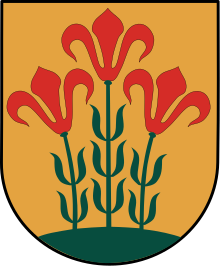
The Alytus District Municipality (Lithuanian: Alytaus rajono savivaldybė) is a municipality in Alytus County, Lithuania, located in the Dzūkija ethnographic region.
This municipality was founded in 1950, and until 1953 was a part of the Kaunas Province. In 1959, another reorganization of parts of the former Simnas and Daugai municipalities occurred, which included the towns of Simnas and Daugai. In 1962 it was expanded more, attaching part of the former Jieznas municipality. In 1968 parts of the municipality were attached to the Prienai District Municipality and Trakai District Municipality, and 1969 another part of Varėna District Municipality. (Full article...) -
Image 14Svobiškėlis mound
The Molėtai District Municipality is one of 60 municipalities in Lithuania.
Molėtai is known for its many lakes. There are about 220 lakes in the district and they cover about 7% of the total territory. Since it is only about 60 km north of Vilnius, many Vilnians own summer homes there. The area offers many recreational opportunities. It is easy to reach Molėtai because there is a highway connecting Vilnius and Utena which divides the district into two almost equal parts. Since there is little industry, the district is proud of its lack of pollution. The land is not very fertile, therefore the district's government is focused on developing tourism. (Full article...) -
Image 15
Neringa () or Neringa Municipality (Lithuanian: Neringos savivaldybė) is a municipality of Klaipėda County in westernmost Lithuania, comprising several villages in the Curonian Spit. In terms of population, it is the smallest municipality of the country. Nida is the seat of government and largest town in Neringa Municipality. (Full article...)
Selected World Heritage Site
-
Image 1The northernmost station of the Struve Geodetic Arc is located in Fuglenes, Norway.
The Struve Geodetic Arc is a chain of survey triangulations stretching from Hammerfest in Norway to the Black Sea, through ten countries and over 2,820 kilometres (1,750 mi), which yielded the first accurate measurement of a meridian arc.
The chain was established and used by the German-born Russian scientist Friedrich Georg Wilhelm von Struve in the years 1816 to 1855 to establish the exact size and shape of the earth. At that time, the chain passed merely through three countries: Norway, Sweden and the Russian Empire. The Arc's first point is located in Tartu Observatory in Estonia, where Struve conducted much of his research. Measurement of the triangulation chain comprises 258 main triangles and 265 geodetic vertices. The northernmost point is located near Hammerfest in Norway and the southernmost point near the Black Sea in Ukraine. (Full article...) -
Image 2
Kaunas (/ˈkaʊnəs/; Lithuanian: [ˈkɐʊ̯ˑnˠɐs] ⓘ; previously known in English as Kovno /ˈkɒvnoʊ/) is the second-largest city in Lithuania after Vilnius, the fourth largest city in the Baltic States and an important centre of Lithuanian economic, academic, and cultural life. Kaunas was the largest city and the centre of a county [pl] in the Duchy of Trakai of the Grand Duchy of Lithuania and Trakai Palatinate since 1413. In the Russian Empire, it was the capital of the Kaunas Governorate from 1843 to 1915.
During the interwar period, it served as the temporary capital of Lithuania, when Vilnius was seized and controlled by Poland between 1920 and 1939. During that period Kaunas was celebrated for its rich cultural and academic life, fashion, construction of countless Art Deco and Lithuanian National Revival architectural-style buildings as well as popular furniture, interior design of the time, and a widespread café culture. The city interwar architecture is regarded as among the finest examples of European Art Deco and has received the European Heritage Label. It contributed to Kaunas being designated as the first city in Central and Eastern Europe as a UNESCO City of Design, and also to becoming a World Heritage Site in 2023 as the only European city representing large scale urbanization during the interwar period and versatile modernism architecture. (Full article...) -
Image 3
Kernavė was a medieval capital of the Grand Duchy of Lithuania and today is a tourist attraction and an archeological site (population 238, 2021). It is located in the Širvintos district municipality located in southeast Lithuania. A Lithuanian state cultural reserve was established in Kernavė in 1989. In 2004 Kernavė Archaeological Site was included into UNESCO World Heritage list. (Full article...) -
Image 4The Valley of Death looking from the Parnidis Dune in Neringa Municipality, Lithuania in October 2022.
The Curonian (Courish) Spit (Lithuanian: Kuršių nerija; Russian: Ку́ршская коса́) is a 98-kilometre (61 mi) long, thin, curved sand-dune spit that separates the Curonian Lagoon from the Baltic Sea. It is a UNESCO World Heritage Site shared by Lithuania and Russia. Its southern portion lies within Kaliningrad Oblast of Russia, and its northern within southwestern Klaipėda County of Lithuania. (Full article...) -
Image 5
The Old Town of Vilnius (Lithuanian: Vilniaus senamiestis), one of the largest surviving medieval old towns in Northern Europe, as inscribed within UNESCO World Heritage Sites, has an area of 3.59 square kilometres (887 acres). It encompasses 74 quarters, with 70 streets and lanes numbering 1487 buildings with a total floor area of 1,497,000 square meters. The administrative division of the Old Town (senamiesčio seniūnija) is a larger territory and comprises more than 4.5 square kilometres. It was founded by the Lithuanian Grand Duke and King of Poland Jogaila in 1387 on the Magdeburg rights the oldest part of the Lithuanian capital of Vilnius, it had been developed over the course of many centuries, and has been shaped by the city's history and a constantly changing cultural influence. It is a place where some of Europe's greatest architectural styles—gothic, renaissance, baroque and neoclassical—stand side by side and complement each other. There are many Catholic, Lutheran and Orthodox churches, residential houses, cultural and architectural monuments, museums in the Old Town.
Pilies Street is the Old Town's main artery and the hub of cafe and street market life. The main street of Vilnius, Gediminas Avenue, is partially located in the Old Town. The central squares in the Old Town are the Cathedral Square and the Town Hall Square. (Full article...)
Selected history article
-
Image 1The Narva culture or eastern Baltic was a European Neolithic archaeological culture in present-day Estonia, Latvia, Lithuania, Kaliningrad Oblast (former East Prussia), and adjacent portions of Poland, Belarus and Russia. A successor of the Mesolithic Kunda culture, the Narva culture continued up to the start of the Bronze Age. The culture spanned from c. 5300 to 1750 BC. The technology was that of hunter-gatherers. The culture was named after the Narva River in Estonia. (Full article...)
-
Image 2
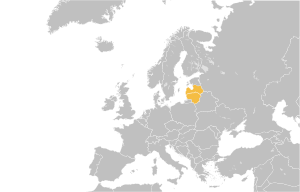
The Balts or Baltic peoples (Lithuanian: baltai, Latvian: balti) are a group of peoples inhabiting the eastern coast of the Baltic Sea who speak Baltic languages. Among the Baltic peoples are modern-day Lithuanians (including Samogitians) and Latvians (including Latgalians) — all East Balts — as well as the Old Prussians, Curonians, Sudovians, Skalvians, Yotvingians and Galindians — the West Balts — whose languages and cultures are now extinct, but made a large influence on the living branches, especially on literary Lithuanian language.
The Balts are descended from a group of Proto-Indo-European tribes who settled the area between the lower Vistula and southeast shore of the Baltic Sea and upper Daugava and Dnieper rivers, and which over time became differentiated into West and East Balts. In the fifth century CE, parts of the eastern Baltic coast began to be settled by the ancestors of the Western Balts, whereas the East Balts lived in modern-day Belarus, Ukraine and Russia. In the first millennium CE, large migrations of the Balts occurred. By the 13th and 14th centuries, the East Balts shrank to the general area that the present-day Balts and Belarusians inhabit. (Full article...) -
Image 3
The Lithuanian–Soviet War or Lithuanian–Bolshevik War (Lithuanian: karas su bolševikais) was fought between newly independent Lithuania and the Russian Socialist Federative Soviet Republic in the aftermath of World War I. It was part of the larger Soviet westward offensive of 1918–1919. The offensive followed the retreat of German troops and sought to establish Soviet republics in Ukraine, Belarus, Lithuania, Latvia, Estonia, Poland and link up with the German Revolution. By the end of December 1918 Soviet forces reached Lithuanian borders. Largely unopposed, they occupied one town after another and by the end of January 1919 controlled about two thirds of the Lithuanian territory. In February, the Soviet advance was stopped by Lithuanian and German volunteers, who prevented the Soviets from capturing Kaunas, the temporary capital of Lithuania. From April 1919, the Lithuanian war went parallel with the Polish–Soviet War. Poland had territorial claims over Lithuania, especially the Vilnius Region; these tensions spilt over into the Polish–Lithuanian War.
British-Polish historian Norman Davies summarized the situation: "the German army was supporting the Lithuanian nationalists, the Soviets were supporting the Lithuanian communists and the Polish Army was fighting them all." In mid-May, the Lithuanian army, now commanded by General Silvestras Žukauskas, began an offensive against the Soviets in Northeastern Lithuania. By mid-June, the Lithuanians reached the Latvian border and cornered the Soviets among lakes and hills near Zarasai, where the Soviets held out until the end of August 1919. The Soviets and Lithuanians, separated by the Daugava River, maintained their fronts until the Battle of Daugavpils in January 1920. As early as September 1919, the Soviets offered to negotiate a peace treaty, but talks began only in May 1920. The Soviet–Lithuanian Peace Treaty was signed on July 12, 1920. Soviet Russia fully recognized independent Lithuania. (Full article...) -
Image 4
The monarchy of Lithuania concerned the monarchical head of state of Lithuania, which was established as an absolute and hereditary monarchy. Throughout Lithuania's history there were three ducal dynasties—the House of Mindaugas, the House of Gediminas, and the House of Jagiellon. Despite this, the one and only crowned king of Lithuania was King Mindaugas I. In two more instances, royal nobles were not crowned due to political circumstances, but held de jure recognition abroad —Vytautas the Great by Sigismund, Holy Roman Emperor, and Mindaugas II by Pope Benedict XV.
Others were seen as kings of Lithuania even though they had only considered it and never took further action to claim the throne, as in the case of Gediminas who was recognised as king of Lithuania by Pope John XXII. The hereditary monarchy in Lithuania was first established in the 13th century during the reign of Mindaugas I and officially re-established as a constitutional monarchy on 11 July 1918, only to be abandoned soon afterwards on 2 November 1918. (Full article...) -
Image 5Early dukes of Lithuania (including Samogitia) reigned before Lithuanians were unified by Mindaugas into a state, the Grand Duchy of Lithuania. While the Palemonids legend provides genealogy from the 10th century, only few dukes were mentioned by contemporary historical sources. All of them were mentioned in written sources the 13th century. Data about them is extremely scarce and is usually limited to few brief sentences. The primary sources are the Chronicle of Henry of Livonia and Hypatian Codex. (Full article...)
-
Image 6

Lithuania, officially the Republic of Lithuania, is a country in the Baltic region of Europe. It is one of three Baltic states and lies on the eastern shore of the Baltic Sea, bordered by Latvia to the north, Belarus to the east and south, Poland to the south, and the Russian semi-exclave of Kaliningrad Oblast to the southwest, with a maritime border with Sweden to the west. Lithuania covers an area of 65,300 km2 (25,200 sq mi), with a population of 2.89 million. Its capital and largest city is Vilnius; other major cities include Kaunas, Klaipėda, Šiauliai and Panevėžys. Lithuanians belong to the linguistic group of the Balts and speak Lithuanian.
For millennia, the southeastern shores of the Baltic Sea were inhabited by various Baltic tribes. In the 1230s, Lithuanian lands were united for the first time by Mindaugas, who formed the Kingdom of Lithuania on 6 July 1253. Subsequent expansion and consolidation resulted in the Grand Duchy of Lithuania, which by the 14th century was the largest country in Europe. In 1386, the Grand Duchy entered into a de facto personal union with the Crown of the Kingdom of Poland. The two realms were united into the bi-confederal Polish-Lithuanian Commonwealth in 1569, forming one of the largest and most prosperous states in Europe. The Commonwealth lasted more than two centuries, until neighbouring countries gradually dismantled it between 1772 and 1795, with the Russian Empire annexing most of Lithuania's territory. (Full article...) -
Image 7The history of Lithuania between 1219 and 1295 concerns the establishment and early history of the first Lithuanian state, the Grand Duchy of Lithuania. The beginning of the 13th century marks the end of the prehistory of Lithuania. From this point on the history of Lithuania is recorded in chronicles, treaties, and other written documents. In 1219, 21 Lithuanian dukes signed a peace treaty with Galicia–Volhynia. This event is widely accepted as the first proof that the Baltic tribes were uniting and consolidating. Despite continuous warfare with two Christian orders, the Livonian Order and the Teutonic Knights, the Grand Duchy of Lithuania was established and gained some control over the lands of Black Ruthenia, Polatsk, Minsk, and other territories east of modern-day Lithuania that had become weak and vulnerable after the collapse of Kievan Rus'.
The first ruler to hold the title of Grand Duke was Mindaugas. Traditionally he is considered the founder of the state, the one who united the Baltic tribes and established the Duchy. Some scholars, however, challenge this perception, arguing that an organized state existed before Mindaugas, possibly as early as 1183. After quelling an internal war with his nephews, Mindaugas was baptized in 1251, and was crowned as King of Lithuania in 1253. In 1261, he broke the peace with the Livonian Order, perhaps even renouncing Christianity. His assassination in 1263 by Treniota ended the early Christian kingdom in Lithuania. For another 120 years Lithuania would remain a pagan empire, fighting against the Teutonic and Livonian Orders during the Northern Crusades during their attempts to Christianize the land. (Full article...) -
Image 8
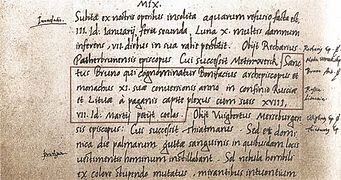
Lithuania's name in writing, 1009
The first known record of the name of Lithuania (Lithuanian: Lietuva) was recorded in the Quedlinburg Chronicle (Latin: Annales Quedlinburgenses, written between 1008 and 1030) in a 9 March 1009 story of Saint Bruno. The Chronicle recorded in the form Litua (in the phrase "in confinio Rusciæ et Lituæ a paganis capite plexus"). Although it is clear the name originated from a Baltic language, scholars still debate the meaning of the word. (Full article...) -
Image 9
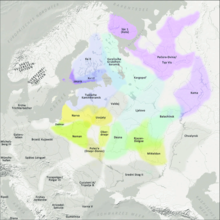
The archaeological Neman culture (German: Memel-Kultur) existed from about 5100 to the 3rd millennium BC, starting in the Mesolithic and continued into the middle Neolithic. It was located in the upper basin of the Neman River (present-day northern Poland, southern Lithuania, western Belarus and Kaliningrad Oblast). In the north, the Neman culture bordered the Kunda culture during the Mesolithic and the Narva culture during the Neolithic. (Full article...) -
Image 10
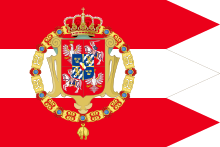
Swedish Lithuania, officially known as the Grand Duchy of Lithuania (Swedish: Storfurstendömet Litauen, Latin: Magnus Ducatus Lituaniæ), was a dominium directum protectorate of the Swedish Empire under the rule of King Charles X Gustav in accordance with the Union of Kėdainiai. It de jure existed from 1655 until 1657 when it was terminated and fully reincorporated into the Polish–Lithuanian Commonwealth. (Full article...) -
Image 11

Volunteers of the Lithuanian Army heading to the war in Vilkaviškis, 1919
The Lithuanian Wars of Independence, also known as the Freedom Struggles (Lithuanian: Laisvės kovos), refer to three wars Lithuania fought defending its independence at the end of World War I: with Bolshevik forces (December 1918 – August 1919), Bermontians (October 1919 – December 1919), and Poland (August 1920 – November 1920). The wars delayed international recognition of independent Lithuania and the formation of civil institutions. (Full article...) -
Image 12
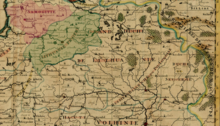
Lithuania proper (in green) and Samogitia (in red) within the Grand Duchy of Lithuania in a map from 1712
Lithuania proper refers to a region that existed within the Grand Duchy of Lithuania where the Lithuanian language was spoken. The primary meaning is identical to the Duchy of Lithuania, a land around which the Grand Duchy of Lithuania evolved. The territory can be traced by Catholic Christian parishes established in pagan Baltic lands of the Grand Duchy of Lithuania subsequent to the Christianization of Lithuania in 1387. Lithuania proper (Lithuania Propria) was always distinguished from the Ruthenian lands since the Lithuanians differed from the Ruthenians in their language and faith (Paganism in the beginning and Catholicism since 1387). The term in Latin was widely used during the Middle Ages and can be found in numerous historical maps until World War I.
Lithuania proper is sometimes also called Lithuania Major, particularly in contrast with Lithuania Minor. (Full article...) -
Image 13
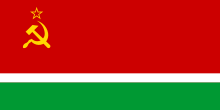
The Lithuanian Soviet Socialist Republic (Lithuanian SSR; Lithuanian: Lietuvos Tarybų Socialistinė Respublika; Russian: Литовская Советская Социалистическая Республика, romanized: Litovskaya Sovetskaya Sotsialisticheskaya Respublika), also known as Soviet Lithuania or simply Lithuania, was de facto one of the constituent republics of the Soviet Union between 1940–1941 and 1944–1990. After 1946, its territory and borders mirrored those of today's Republic of Lithuania, with the exception of minor adjustments to its border with Belarus.
During World War II, the previously independent Republic of Lithuania was occupied by the Red Army on 16 June 1940, in conformity with the terms of the 23 August 1939 Molotov–Ribbentrop Pact, and established as a puppet state on 21 July. Between 1941 and 1944, the German invasion of the Soviet Union caused its de facto dissolution. However, with the retreat of the Germans in 1944–1945, Soviet hegemony was re-established and continued for forty-five years. As a result, many Western countries continued to recognize Lithuania as an independent, sovereign de jure state subject to international law, represented by the legations appointed by the pre-1940 Baltic states, which functioned in various places through the Lithuanian Diplomatic Service. (Full article...) -
Image 14
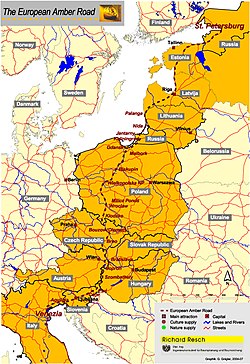
The Amber Road (east route), as hypothesized by Polish historian Jerzy Wielowiejski, Główny szlak bursztynowy w czasach Cesarstwa Rzymskiego (Main Route of the Amber Road of the Roman Empire), 1980
The Amber Road was an ancient trade route for the transfer of amber from coastal areas of the North Sea and the Baltic Sea to the Mediterranean Sea. Prehistoric trade routes between Northern and Southern Europe were defined by the amber trade.
As an important commodity, sometimes dubbed "the gold of the north", amber was transported from the North Sea and Baltic Sea coasts overland by way of the Vistula and Dnieper rivers to Italy, Greece, the Black Sea, Syria and Egypt over a period of thousands of years. (Full article...) -
Image 15
Yotvingia or Sudovia (Yotvingian: Sūdava, Lithuanian: Dainava, Polish: Jaćwież, German: Sudauen, Eastern Slavic: Яцьвезь (Ятвязь, Етвязь), Ятвягия) was a region where the Baltic tribe known as Yotvingians lived. It was located in the area of Sudovia and Dainava; south west from the upper Nemunas, between Marijampolė, Merkinė (Lithuania), Slonim, Kobryn (Belarus), Białystok, and Ełk (Poland).
Today this area corresponds mostly to the Podlaskie Voivodeship of Poland, part of Lithuania and a part of Hrodna Province and Brest Province of Belarus. (Full article...)
Selected politics article
-
Image 1
Gintautas Paluckas (Lithuanian: [ˈɡʲɪntˠɐʊtˠɐs pˠɐˈlˠʊtskɐs]; born 19 August 1979) is a Lithuanian politician serving as the 18th prime minister of Lithuania since December 2024. Paluckas served as Deputy Mayor of Vilnius from 2015 to 2019, as the leader of the Lithuanian Social Democratic Party (LSDP) from 2017 to 2021 and has been a member of the Seimas since the 2020 election. (Full article...) -
Image 2

Seniūnijos of Lithuania
A seniūnija (in English: eldership, elderate, ward, parish, or subdistrict) is the smallest administrative division of Lithuania. An eldership may comprise a very small region consisting of few villages, one single town, or a part of a big city. Elderships vary in size and population depending on their location and nature. A few elderships make up a municipality. Šilainiai, Dainava, Verkiai, Žirmūnai and Pašilaičiai are the most populous elderates, with population counts over 40,000, around twice the population of some entire municipalities. (Full article...) -
Image 3
Parliamentary elections were held in Lithuania on 9 and 23 October 2016 to elect the 141 members of the Seimas. 71 were elected in single-member constituencies using the two-round system, and the remaining 70 in a single nationwide constituency using proportional representation. The first round was held on 9 October and the second round on 23 October. (Full article...) -
Image 4
Dr. Danguolė Bublienė is a Lithuanian lawyer and judge who is currently serving as the President of the Supreme Court of Lithuania. She is the first woman to hold this position in the history of the Lithuanian judiciary. Her career spans various legal roles, where she has earned recognition for her expertise in civil law and her commitment to ensuring justice. (Full article...) -
Image 5
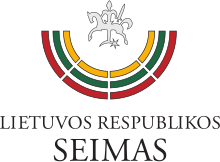
The Seimas of the Republic of Lithuania (Lithuanian: Lietuvos Respublikos Seimas), or simply the Seimas (/ˈseɪməs/ SAY-məs; Lithuanian: [ˈsɛɪˑmɐs]), is the unicameral legislative body of the Republic of Lithuania. The Seimas constitutes the legislative branch of government in Lithuania, enacting laws and amendments to the Constitution, passing the budget, confirming the Prime Minister and the Government and controlling their activities. (Full article...) -
Image 6
The President of the Constitutional Court of Lithuania (Lithuanian: Lietuvos Konstitucinio Teismo pirmininkas) is the chief justice of the Constitutional Court, overseeing its full bench of nine justices. The president represents the Court and leads its proceedings, ensuring the constitutionality of laws and acts. (Full article...) -
Image 7

Gitanas Nausėda (/ɡɪˈtɑːnəs naʊˈsɛdə/; Lithuanian: [ɡʲɪˈtˠɐnˠɐs nˠɐʊˈsʲeːdˠɐ]; born 19 May 1964) is a Lithuanian politician, economist, and banker who is serving as the ninth and incumbent president of Lithuania since 2019. Born in Klaipėda, Nausėda graduated from Vilnius University with an economics degree in 1987. He was director of monetary policy at the Bank of Lithuania from 1996 to 2000 and chief economist to the chairman of SEB bankas from 2008 to 2018. (Full article...) -
Image 8
Election campaign poster in Vilnius
The 2014 European Parliament election in Lithuania was an election of the delegation from Lithuania to the European Parliament in 2014. It was part of the wider 2014 European election. (Full article...) -
Image 9

Lithuanian municipalities and elderships map
Lithuania is divided into three levels of administrative divisions. The first-level division consists of 10 counties (Lithuanian: singular – apskritis, plural – apskritys). These are sub-divided into 60 municipalities (Lithuanian: plural – savivaldybės, singular – savivaldybė), which in turn are further sub-divided into over 500 smaller groups, known as elderships (Lithuanian: plural – seniūnijos, singular – seniūnija). (Full article...) -
Image 10

Presidential elections were held in Lithuania on 11 May 2014, with a second round held on 25 May between the top two candidates from the first round. In the second round, incumbent President Dalia Grybauskaitė was re-elected with 58% of the vote. Second round took place alongside the 2014 European elections. (Full article...) -
Image 11
Nida Grunskienė (Lithuanian: [/ˈnɪdɐ ˈɡrʊnˌskʲɛːnʲɛ/]; born 21 May 1969) is a Lithuanian jurist and legal expert who has been serving as the Prosecutor General of Lithuania since 14 January 2021. She also served as the Chief Prosecutor of the Panevėžys Regional Prosecutor’s Office from 2013 to 2021, where she gained extensive experience in handling criminal cases, particularly in the areas of organized crime and corruption. (Full article...) -
Image 12
Gintaras Goda (Lithuanian: [ˈɡʲɪn̪t̪ɐrɐs ˈɡʲɐ̂ːd̪ɐ]; born 13 June 1965) is a Lithuanian judge, legal researcher, comparative criminal procedure expert and professor at the Faculty of Law of Vilnius University who is currently serving as President of the Constitutional Court of Lithuania since 2023. He had been a Judge of the Supreme Administrative Court of Lithuania from 2002 to 2005 and was Judge of the Supreme Court of Lithuania from 2005 to 2017. (Full article...) -
Image 13

The Prosecutor General of Lithuania (Lithuanian: Lietuvos Generalinis Prokuroras) is the chief and head of the Prosecutor General's Office of Lithuania and is the highest-ranking official within the Lithuanian prosecutorial system. The current incumbent is Nida Grunskienė. (Full article...) -
Image 14
Seimas Palace (Lithuanian: Seimo rūmai) is the seat of the Seimas, the Lithuanian parliament. It is located in Lithuania's capital Vilnius. (Full article...) -
Image 15The territory of Lithuania is divided into 10 counties (Lithuanian: singular apskritis, plural apskritys), all named after their capitals. The counties are divided into 60 municipalities (Lithuanian: singular savivaldybė, plural savivaldybės): 9 city municipalities, 43 district municipalities and 8 municipalities. Each municipality is then divided into elderates (Lithuanian: singular seniūnija, plural seniūnijos). This division was created in 1994 and slightly modified in 2000. (Full article...)
Selected biography
-
Image 1
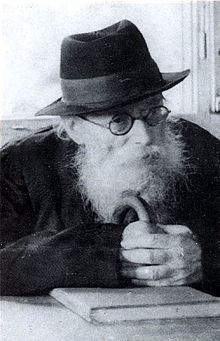
Avraham Yeshaya Karelitz (7 November 1878 – 24 October 1953), also known as the Chazon Ish (Hebrew: החזון איש) after his magnum opus, was a Belarusian-born Orthodox rabbi who later became one of the leaders of Haredi Judaism in Israel, where he spent his final 20 years, from 1933 to 1953. (Full article...) -
Image 2

Handrpint of Smoriginas at the "Walk of Fame", Nida, Lithuania
Kostas Smoriginas (born April 22, 1953) is a Lithuanian theatre and cinema actor and musician.
During 1995–1998, he, together with actors Saulius Bareikis [lt] and Olegas Ditkovskis [lt], formed a musical group "Actors' Trio" ("Aktorių trio"), toured Lithuania and abroad and released several albums. Since the 2000s he performs solo. (Full article...) -
Image 3

Lithuania, officially the Republic of Lithuania, is a country in the Baltic region of Europe. It is one of three Baltic states and lies on the eastern shore of the Baltic Sea, bordered by Latvia to the north, Belarus to the east and south, Poland to the south, and the Russian semi-exclave of Kaliningrad Oblast to the southwest, with a maritime border with Sweden to the west. Lithuania covers an area of 65,300 km2 (25,200 sq mi), with a population of 2.89 million. Its capital and largest city is Vilnius; other major cities include Kaunas, Klaipėda, Šiauliai and Panevėžys. Lithuanians belong to the linguistic group of the Balts and speak Lithuanian.
For millennia, the southeastern shores of the Baltic Sea were inhabited by various Baltic tribes. In the 1230s, Lithuanian lands were united for the first time by Mindaugas, who formed the Kingdom of Lithuania on 6 July 1253. Subsequent expansion and consolidation resulted in the Grand Duchy of Lithuania, which by the 14th century was the largest country in Europe. In 1386, the Grand Duchy entered into a de facto personal union with the Crown of the Kingdom of Poland. The two realms were united into the bi-confederal Polish-Lithuanian Commonwealth in 1569, forming one of the largest and most prosperous states in Europe. The Commonwealth lasted more than two centuries, until neighbouring countries gradually dismantled it between 1772 and 1795, with the Russian Empire annexing most of Lithuania's territory. (Full article...) -
Image 4
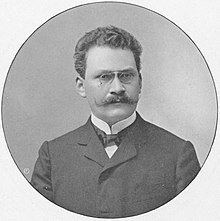
Hermann Minkowski (/mɪŋˈkɔːfski, -ˈkɒf-/ ming-KAWF-skee, -KOF-; German: [mɪŋˈkɔfski]; 22 June 1864 – 12 January 1909) was a mathematician and professor at the University of Königsberg, the University of Zürich, and the University of Göttingen, described variously as German, Polish, Lithuanian-German, or Russian. He created and developed the geometry of numbers and elements of convex geometry, and used geometrical methods to solve problems in number theory, mathematical physics, and the theory of relativity.
Minkowski is perhaps best known for his foundational work describing space and time as a four-dimensional space, now known as "Minkowski spacetime", which facilitated geometric interpretations of Albert Einstein's special theory of relativity (1905). (Full article...) -
Image 5
Antanas Guoga (born 17 December 1973), more commonly known as Tony G, is a Lithuanian-Australian businessman, poker player, politician and philanthropist. In November 2020, Antanas was elected to the 2020–2024 legislative period of the Seimas of the Republic of Lithuania in the Labour Party group.
During 2014–2019 he was a Member of the European Parliament for the Liberal Movement, and from 2016 the European Peoples Party. In May 2016, Guoga was the temporary leader of the Liberal Movement following the bribery scandal that prompted Eligijus Masiulis to step down after potentially corrupt activities. (Full article...) -
Image 6Ilgauskas with the Cleveland Cavaliers in November 2009
Zydrunas Ilgauskas (Lithuanian: Žydrūnas Ilgauskas; Lithuanian pronunciation: [ʑiːˈdrûːnɐs ɪɫˈɡɐ̂ˑʊ̯skɐs] ⓘ; born June 5, 1975) is a Lithuanian-born American former professional basketball player who played the center position. The 7'3" Ilgauskas played for the Cleveland Cavaliers of the National Basketball Association from 1997 to 2010 and played for the Miami Heat during the 2010–11 season. He was named to the 1997–98 All-Rookie First Team and is a two-time NBA All-Star.
Ilgauskas played in the 2007 NBA Finals as a member of the Cavaliers. He is known for his accurate jump shot, for his rebounding, and for overcoming difficult injury challenges during his career. Nicknamed Big Z, Ilgauskas is the Cavaliers' career leader in blocked shots; his jersey no. 11 has been retired by the team. In 2012, Ilgauskas joined the Cavaliers' front office, becoming a special advisor to the organization. (Full article...) -
Image 7
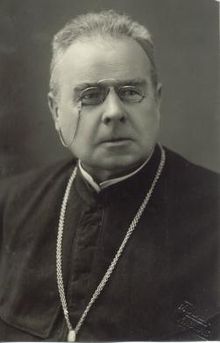
Maironis (born Jonas Mačiulis, Lithuanian: Jonas Mačiulis; 2 November [O.S. 21 October] 1862 – 28 June 1932) was a Lithuanian Roman Catholic priest and the greatest and most-known Lithuanian poet, especially of the period of the Lithuanian press ban. He was called the Bard of Lithuanian National Revival (Tautinio atgimimo dainius). Maironis was active in public life. However, the Lithuanian literary historian Juozas Brazaitis writes that Maironis was not.
In his poetry, he expressed the national aspirations of the Lithuanian National Revival and was highly influential in Lithuanian society and poetry. The Maironian school in Lithuanian literature was named after him. (Full article...) -
Image 8Algirdas Julien Greimas (French: [alɡiʁdas ʒyljɛ̃ gʁɛmas]; born Algirdas Julius Greimas; 9 March 1917 – 27 February 1992) was a Lithuanian literary scientist who wrote most of his body of work in French while living in France. Greimas is known among other things for the Greimas Square (le carré sémiotique). He is, along with Roland Barthes, considered the most prominent of the French semioticians. With his training in structural linguistics, he added to the theory of signification, plastic semiotics, and laid the foundations for the Parisian school of semiotics. Among Greimas's major contributions to semiotics are the concepts of isotopy, the actantial model, the narrative program, and the semiotics of the natural world. He also researched Lithuanian mythology and Proto-Indo-European religion, and was influential in semiotic literary criticism. (Full article...)
-
Image 9Kęstutis Kemzūra, while coaching Lithuania's national team, at EuroBasket 2011
Kęstutis Kemzūra (born 20 April 1970) is a Lithuanian professional basketball coach and former player who is currently the head coach of Juventus Utena of the Lithuanian Basketball League. During his playing career, at a height of 1.91 m (6'3") tall, he played at the point guard position. (Full article...) -
Image 10Justė Juozapaitytė (born 19 April 1990) is a Lithuanian model, beauty pageant contestant and entrepreneur. (Full article...)
-
Image 11

Hermann Minkowski (/mɪŋˈkɔːfski, -ˈkɒf-/ ming-KAWF-skee, -KOF-; German: [mɪŋˈkɔfski]; 22 June 1864 – 12 January 1909) was a mathematician and professor at the University of Königsberg, the University of Zürich, and the University of Göttingen, described variously as German, Polish, Lithuanian-German, or Russian. He created and developed the geometry of numbers and elements of convex geometry, and used geometrical methods to solve problems in number theory, mathematical physics, and the theory of relativity.
Minkowski is perhaps best known for his foundational work describing space and time as a four-dimensional space, now known as "Minkowski spacetime", which facilitated geometric interpretations of Albert Einstein's special theory of relativity (1905). (Full article...) -
Image 12
Anthony Kiedis (/ˈkiːdɪs/ KEE-dis; born November 1, 1962) is an American musician and lead vocalist of the rock band Red Hot Chili Peppers. Kiedis and his fellow band members were inducted into the Rock and Roll Hall of Fame in 2012.
Kiedis spent his youth in Grand Rapids, Michigan, with his mother, and then moved shortly before his twelfth birthday to live with his father in Hollywood. While attending Fairfax High School, Kiedis befriended students Flea and Hillel Slovak, who were members of the band Anthym. After high school, Kiedis took classes at UCLA, but dropped out in his sophomore year. (Full article...) -
Image 13
Eglė Špokaitė (born 1971 in Vilnius) is a Lithuanian ballet dancer, most notably a Principal Ballerina for the Lithuanian National Opera and Ballet Theatre (1989–2011) and the only ballet dancer on the List of Famous Lithuanians. She co-founded the Egle Špokaitė Ballet School in Vilnius, Lithuania (2008), where she also served as artistic director. In the United States, she founded the Ballet Institute of San Diego dance school (2016). Špokaitė is also a choreographer, actress, and public speaker. She's the winner of the Lithuanian National Prize, as well as numerous other awards and honors. She lives and works between San Diego, CA and Vilnius. (Full article...)
Associated Wikimedia
The following Wikimedia Foundation sister projects provide more on this subject:
-
Commons
Free media repository -
Wikibooks
Free textbooks and manuals -
Wikidata
Free knowledge base -
Wikinews
Free-content news -
Wikiquote
Collection of quotations -
Wikisource
Free-content library -
Wikiversity
Free learning tools -
Wikivoyage
Free travel guide -
Wiktionary
Dictionary and thesaurus














![Image 13The earliest known Lithuanian glosses (between 1520 and 1530) written in the margins of Johann Herolt book Liber Discipuli de eruditione Christifidelium. Words: teprÿdav[ſ]ʒÿ (let it strike), vbagÿſte (indigence). (from Lithuania)](http://upload.wikimedia.org/wikipedia/commons/thumb/f/f6/The_earliest_known_Lithuanian_glosses_%28~1520%E2%80%931530%29%2C_words_%28tepridau%C5%BEia%2C_ubagyst%C4%97%29.jpg/120px-The_earliest_known_Lithuanian_glosses_%28~1520%E2%80%931530%29%2C_words_%28tepridau%C5%BEia%2C_ubagyst%C4%97%29.jpg)

























































































